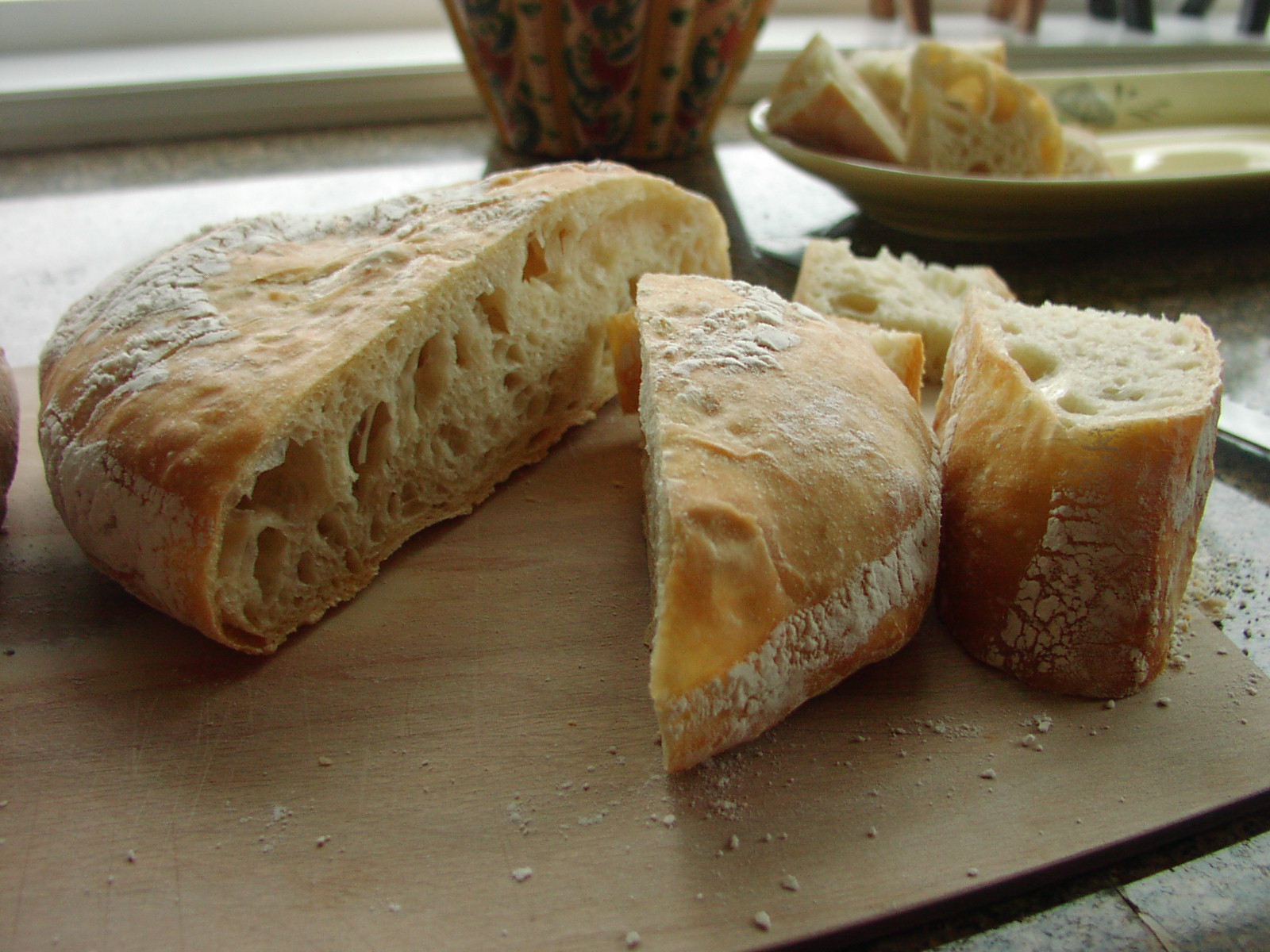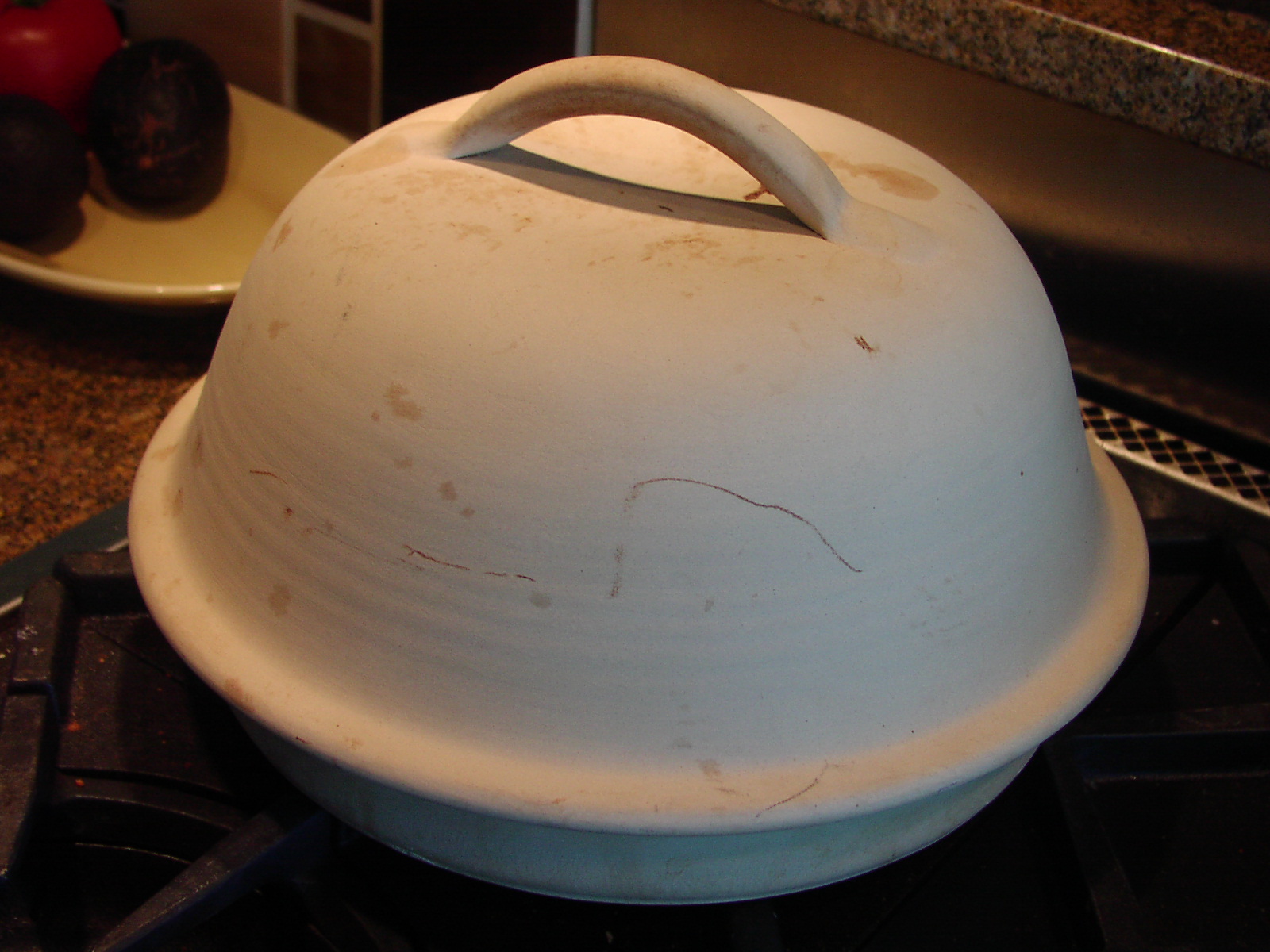In reality there is nothing magical about baking a wonderful loaf of bread. (Well the yeast going from dormant in your refrigerator to crazy hungry in your dough is sort of amazing, but that’s as close to “magical” as bread-baking really gets!)
So during my recent quest for a recipe that produced a delicious and chewy bread that I could mix up one day and bake in my cloche* the next, I stumbled upon this recipe from Jim Lahey, owner of Sullivan Street Bakery in New York City.
The recipe was first featured in the New York Times, and it remains one of the most popular recipes the paper ever published. And for very good reason! And truly, it does feel like some sort of magic is involved because the final product is so delicious, yet the recipe is so incredibly easy to prepare! There is no guessing about how much flour is the right amount of flour to use. There is no kneading involved, so even if you don’t own a stand-up mixer with a dough hook, or your fingers (like mine) are too arthritic to spend any quality time pummeling a ball of dough, you are still going to be able to produce a fantastic loaf of artisan style bread.
And I’m sorry Mr. Lahey, but I did make a couple of insignificant changes to your recipe. I didn’t use instant yeast** (also known as “fast-rising” or “fast-acting” yeast) because I knew that regular old fashioned active dry yeast would catch up with instant yeast during the long initial rising period. (Plus I didn’t have any instant yeast on hand.) I also reduced the amount of water from 1 5/8 cups to 1½ cups. (As I was mixing the dough, I felt it was wet enough with the lesser amount of liquid.) And I used sea salt rather than regular salt. (And no I don’t know why. It just seemed like the right thing to do at the time!) I also chose to use bread flour even though the recipe called for either all-purpose or bread flour. (I just felt bread flour was the better choice.)
Anyway, whatever I did, be it right or wrong, the bread turned out simply delicious. And the chewy texture was divine. And I know what a few of you will be thinking after you read this recipe. “I don’t have a cloche or a Dutch oven, so I can’t bake this bread.” Well, yes you can. If you have a baking sheet, you can bake this bread! (If you don’t even own a baking sheet because you never really figured you needed one, then you really are out of luck. You might as well leave this site immediately and go pay a visit to your local bakery!)
But if you are serious about baking wonderful breads, I suggest you invest in either a cloche or a really good, enamel lined Dutch oven. If you are going to spend some money, the Dutch oven is probably the better choice. Along with baking bread, you can use a Dutch oven to prepare everything from soup to braised meat in the oven. If you are leaning in the direction of a Dutch oven, I recommend Le Creuset. They ain’t cheap, but worth every penny.
But personally, if push comes to shove, I would still choose a cloche over a Dutch oven for turning out the perfect loaf. (Old habits are very hard to break.) But when it comes to making soup or braising meat in the oven, a Le Creuset Dutch oven would win every time, hands down!
- 3 c. unbleached all-purpose bread flour (use a good brand like Bob’s Red Mill or Oroweat)
- ¼ tsp. active dry yeast
- 1¼ tsp. sea salt
- 1½ c. water
- vegetable oil
- a cloche (round clay bread baker) or a Dutch oven (like a number 28 Le Creuset Cast Iron Round Dutch Oven)
In a large bowl or the bowl of your stand mixer, combine flour, yeast, and salt. If you are using your stand mixer, use the regular paddle rather than the bread hook. This is really a no knead bread, so the regular paddle works best. Add the water and stir until well combined. The dough will be wet and sticky, with a kind of shaggy appearance. (And yes, even though I don’t really need to use my stand-up mixer, I do. The reason being – I’m lazy. No other reason.)
Transfer the dough to an oiled bowl or leave in the bowl of your stand mixer and pour a little oil over the dough; form into a lightly greased ball; cover loosely with plastic wrap. Let dough rest for about 18 hours at room temperature (about 70 degrees). The dough is ready when it has nearly doubled in volume.*** The surface will also be dotted with bubbles.
Next, flour a sheet of parchment paper and place the dough on top. Flour your hands and fold the dough in half and then fold it again. (This action deflates the air bubbles that have formed.)
Add additional flour to the parchment paper as needed and shape the dough into a ball by tucking the sides underneath. Place seam side down onto the paper. Cover loosely with oiled plastic wrap and let rest again until puffy in shape and about doubled in bulk, about 2 hours.
About 30 minutes before your bread is ready to bake, place the lid and the bottom of your cloche**** in the oven and preheat to 425 degrees. Cut a piece of parchment paper roughly the diameter of your cloche and set aside. When the dough is ready, remove the clay baker and lid from the oven, place the newly cut piece of parchment paper on the bottom portion of the hot cloche, slide your hand underneath the parchment paper and dough, and invert the dough onto the parchment paper lined cloche. The seam will be facing up. It will look kind of scary, but the top will be beautifully rustic looking when baked. Shake pan once or twice if dough is unevenly distributed; it will even as it bakes. Carefully cover the bread with the hot lid.
Place in the pre-heated 425 degree oven for 40 minutes, remove the lid, reduce heat to 400 degrees and continue baking for an additional 10-15 minutes or until the crust is a light brown and the loaf sounds hollow when tapped. (You can take the breads temperature by carefully sticking an instant read thermometer into the bottom of the loaf. It should read between 200 and 205 degrees when the bread is fully baked.)
When your bread comes out of the oven, transfer it to a wire rack to cool. Let it cool for at least 1 hour. (Cutting it too soon ruins the texture of the bread. Not what you want!)
*A cloche is a round, bell shaped unglazed stoneware baker that replicates the benefits of baking bread in a brick oven. It turns out individual loaves with tender, moist interiors and crispy, evenly golden crusts. The unglazed clay absorbs heat to ensure even baking on all sides, while the porous surface absorbs moisture to give the crust a crisp texture.
**Instant yeast can shorten the rising time in traditional bread-baking by as much as 50%. But by the end of a long rising period, like the time needed for this recipe, there doesn’t seem to be any difference if you use instant or regular active dry yeast.
***Hint: If your dough isn’t starting to puff or look bubbly after a few hours, place it in the microwave with the light on (keeping the door ajar) or under an upper cabinet fitted with over the counter lighting. (Keep the light on of course!) The warmth from the light will help the yeast start its feeding frenzy.
****A round Dutch oven can also be used with this recipe. Follow the same instructions when using cast iron as given in the preceding paragraphs when using a cloche, including pre-heating the cast iron pan. If you don’t have either a cloche or a cast iron pan, place the dough, after you have shaped it into a round, on a corn meal sprinkled baking stone or baking sheet and follow remaining instructions as written. Except, bake the bread at 425 degrees for 9 minutes; reduce oven temperature to 400 degrees and bake for another 30-35 minutes or until the loaf is light brown and sounds hollow when tapped with your fingers.


